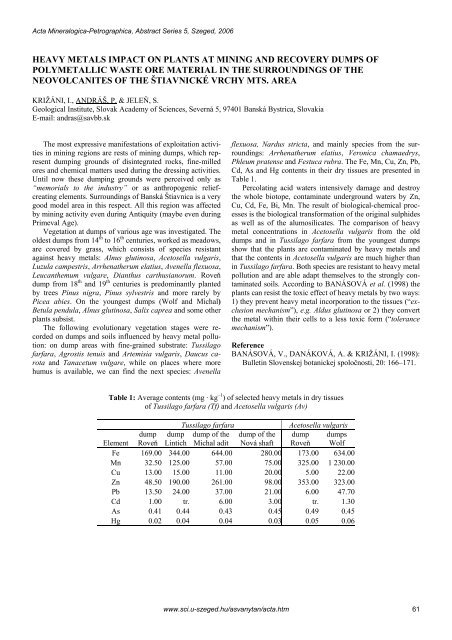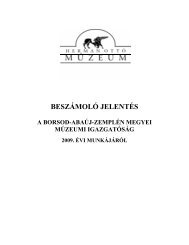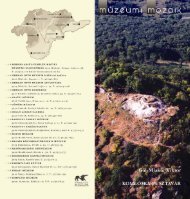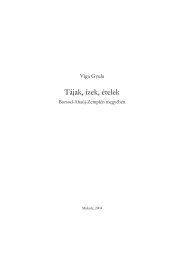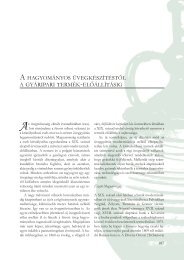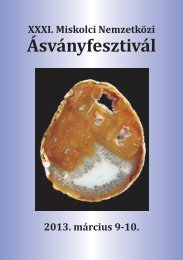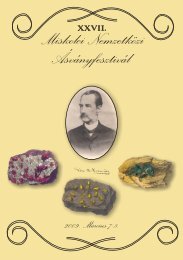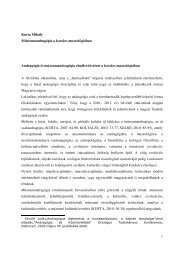Acta Mineralogica-Petrographica, Abstract Series 5, Szeged, 2006MORDENITE <strong>IN</strong> OPHIOLITES FROM <strong>THE</strong> METALIFERI MTS., ROMANIAKRISTÁLY, F. & SZAKÁLL, S.Department of Mineralogy and Petrology, University of Miskolc, H-3515 Miskolc-Egyetemváros, HungaryE-mail: askkf@gold.uni-miskolc.huMordenite is a common zeolite, with sedimentary (bydiagenesis in volcanic tuffs) or hydrothermal origin. Mordeniteis usually found in radial aggregates of acicular orfibrous crystals. Mordenite of hydrothermal origin is a frequentmember in hydrothermal mineral assemblages ofophiolites, or ocean-floor type metamorphosed rocks.Today’s known fibrous zeolites of the Metaliferi Mts. arenatrolite (?) (SZAKÁLL, 2002) and mesolite (BEDELEAN,1971; SZAKÁLL, 2002); mordenite has not been mentionedto date. The two studied occurrences of mordenite in theophiolite type rocks of Metaliferi Mts are at Săliştioara (anabandoned basalt quarry, sample S1) and in the Bodii valleyat Techereu (TB1 sample).At Săliştioara mordenite appears as fine fibrous aggregatesfilling amygdales of the altered basalt, up to 5 mm indiameter. The amygdales are white to pale rose and reddish,due to the hematite inclusions that are usually associated withreddish clinoptilolite.At Techereu mordenite appears as white, fibrous aggregates.The aggregates are nested in the calcite veins filling inthe voids between heulandite crystals. In contrast with theSăliştioara occurrence, in this case the colour of mordenitedoes not vary, but heulandite crystals show a white to reddishcolour zoning.The presence of mordenite was confirmed by X-ray powderdiffraction (Table 1).Five chemical analyses (Table 2) were carried out withEPMA (by Giovanna Vezzalini, at the University of Modena,Italy). H 2 O could not be determined due to the paucity ofavailable material. The results are similar to those publishedby PASSAGLIA (1975). The analyzed samples are Ca-Nadominant, with a low content of K and light variation of exchangeablecations.Samples of the investigated mordenite are deposited inthe mineral collection of the Herman Ottó Museum (Miskolc,Hungary).ReferencesBEDELEAN, I. (1971): Zeoliţii din Munţii Apuseni. Doctoraltheses, Manuscript. Babeş–Bolyai University, Cluj-Napoca.PASSAGLIA, E. (1975): Contributions to Mineralogy andPetrology, 50, 65–70.SZAKÁLL, S. (ed., with the contributions of UDUBAŞA,G., ĎUĎA, R., SZAKÁLL, S., KVASNYTSYA, V.,KOSZOWSKA, E. & NOVÁK, M.) (2002): Minerals ofthe Carpathians. Prague: Granit.Table 1: Strongest reflections of mordenite observed on the XRPD pattern of the samples.TB1 S1 ICDD 29-1257d (Å) I (%) d (Å) I (%) d (Å) I (%) hkl8.809 23.9 8.924 100 9.060 100 2003.968 2.8 3.967 41 4.000 70 1503.490 0.3 3.465 24 3.480 45 2023.374 2.7 3.375 39 3.390 35 3503.267 0.2 3.199 35 3.220 40 511Table 2: Chemical composition of the samples (EPMA).S1FeO K 2 O CaO Na 2 O SiO 2 Al 2 O 3 Sum0.45 1.17 3.77 2.74 68.52 13.09 89.810.20 0.93 3.78 2.69 68.72 13.50 90.050.30 0.58 4.05 2.59 69.16 13.35 90.210.57 0.67 5.02 2.17 66.93 14.22 90.550.42 0.59 4.20 2.42 68.40 13.42 90.5660www.sci.u-szeged.hu/asvanytan/acta.htm
Acta Mineralogica-Petrographica, Abstract Series 5, Szeged, 2006HEAVY METALS IMPACT ON PLANTS AT M<strong>IN</strong><strong>IN</strong>G AND RECOVERY DUMPS OFPOLYMETALLIC WASTE ORE MATERIAL <strong>IN</strong> <strong>THE</strong> SURROUND<strong>IN</strong>GS OF <strong>THE</strong>NEOVOLCANITES OF <strong>THE</strong> ŠTIAVNICKÉ VRCHY MTS. AREAKRIŽÁNI, I., ANDRÁŠ, P. & JELEŇ, S.Geological Institute, Slovak Academy of Sciences, Severná 5, 97401 Banská Bystrica, SlovakiaE-mail: andras@savbb.skThe most expressive manifestations of exploitation activitiesin mining regions are rests of mining dumps, which representdumping grounds of disintegrated rocks, fine-milledores and chemical matters used during the dressing activities.Until now these dumping grounds were perceived only as“memorials to the industry” or as anthropogenic reliefcreatingelements. Surroundings of Banská Štiavnica is a verygood model area in this respect. All this region was affectedby mining activity even during Antiquity (maybe even duringPrimeval Age).Vegetation at dumps of various age was investigated. Theoldest dumps from 14 th to 16 th centuries, worked as meadows,are covered by grass, which consists of species resistantagainst heavy metals: Alnus glutinosa, Acetosella vulgaris,Luzula campestris, Arrhenatherum elatius, Avenella flexuosa,Leucanthemum vulgare, Dianthus carthusianorum. Roveňdump from 18 th and 19 th centuries is predominantly plantedby trees Pinus nigra, Pinus sylvestris and more rarely byPicea abies. On the youngest dumps (Wolf and Michal)Betula pendula, Alnus glutinosa, Salix caprea and some otherplants subsist.The following evolutionary vegetation stages were recordedon dumps and soils influenced by heavy metal pollution:on dump areas with fine-grained substrate: Tussilagofarfara, Agrostis tenuis and Artemisia vulgaris, Daucus carotaand Tanacetum vulgare, while on places where morehumus is available, we can find the next species: Avenellaflexuosa, Nardus stricta, and mainly species from the surroundings:Arrhenatherum elatius, Veronica chamaedrys,Phleum pratense and Festuca rubra. The Fe, Mn, Cu, Zn, Pb,Cd, As and Hg contents in their dry tissues are presented inTable 1.Percolating acid waters intensively damage and destroythe whole biotope, contaminate underground waters by Zn,Cu, Cd, Fe, Bi, Mn. The result of biological-chemical processesis the biological transformation of the original sulphidesas well as of the alumosilicates. The comparison of heavymetal concentrations in Acetosella vulgaris from the olddumps and in Tussilago farfara from the youngest dumpsshow that the plants are contaminated by heavy metals andthat the contents in Acetosella vulgaris are much higher thanin Tussilago farfara. Both species are resistant to heavy metalpollution and are able adapt themselves to the strongly contaminatedsoils. According to BANÁSOVÁ et al. (1998) theplants can resist the toxic effect of heavy metals by two ways:1) they prevent heavy metal incorporation to the tissues (“exclusionmechanism”), e.g. Aldus glutinosa or 2) they convertthe metal within their cells to a less toxic form (“tolerancemechanism”).ReferenceBANÁSOVÁ, V., DANÁKOVÁ, A. & KRIŽÁNI, I. (1998):Bulletin Slovenskej botanickej spoločnosti, 20: 166–171.Table 1: Average contents (mg · kg –1 ) of selected heavy metals in dry tissuesof Tussilago farfara (Tf) and Acetosella vulgaris (Av)Tussilago farfaraAcetosella vulgarisElementdumpRoveňdumpLintichdump of theMichal aditdump of theNová shaftdumpRoveňdumpsWolfFe 169.00 344.00 644.00 280.00 173.00 634.00Mn 32.50 125.00 57.00 75.00 325.00 1 230.00Cu 13.00 15.00 11.00 20.00 5.00 22.00Zn 48.50 190.00 261.00 98.00 353.00 323.00Pb 13.50 24.00 37.00 21.00 6.00 47.70Cd 1.00 tr. 6.00 3.00 tr. 1.30As 0.41 0.44 0.43 0.45 0.49 0.45Hg 0.02 0.04 0.04 0.03 0.05 0.06www.sci.u-szeged.hu/asvanytan/acta.htm 61
- Page 1:
MSCC33 rd MINERAL SCIENCES IN THE C
- Page 5 and 6:
Acta Mineralogica-Petrographica, Ab
- Page 7 and 8:
Acta Mineralogica-Petrographica, Ab
- Page 9 and 10: Acta Mineralogica-Petrographica, Ab
- Page 11 and 12: Acta Mineralogica-Petrographica, Ab
- Page 13 and 14: Acta Mineralogica-Petrographica, Ab
- Page 15 and 16: Acta Mineralogica-Petrographica, Ab
- Page 17 and 18: Acta Mineralogica-Petrographica, Ab
- Page 19 and 20: Acta Mineralogica-Petrographica, Ab
- Page 21 and 22: Acta Mineralogica-Petrographica, Ab
- Page 23 and 24: Acta Mineralogica-Petrographica, Ab
- Page 25 and 26: Acta Mineralogica-Petrographica, Ab
- Page 27 and 28: Acta Mineralogica-Petrographica, Ab
- Page 29 and 30: Acta Mineralogica-Petrographica, Ab
- Page 31 and 32: Acta Mineralogica-Petrographica, Ab
- Page 33 and 34: Acta Mineralogica-Petrographica, Ab
- Page 35 and 36: Acta Mineralogica-Petrographica, Ab
- Page 37 and 38: Acta Mineralogica-Petrographica, Ab
- Page 39 and 40: Acta Mineralogica-Petrographica, Ab
- Page 41 and 42: Acta Mineralogica-Petrographica, Ab
- Page 43 and 44: Acta Mineralogica-Petrographica, Ab
- Page 45 and 46: Acta Mineralogica-Petrographica, Ab
- Page 47 and 48: Acta Mineralogica-Petrographica, Ab
- Page 49 and 50: Acta Mineralogica-Petrographica, Ab
- Page 51 and 52: Acta Mineralogica-Petrographica, Ab
- Page 53 and 54: Acta Mineralogica-Petrographica, Ab
- Page 55 and 56: Acta Mineralogica-Petrographica, Ab
- Page 57 and 58: Acta Mineralogica-Petrographica, Ab
- Page 59: Acta Mineralogica-Petrographica, Ab
- Page 63 and 64: Acta Mineralogica-Petrographica, Ab
- Page 65 and 66: Acta Mineralogica-Petrographica, Ab
- Page 67 and 68: Acta Mineralogica-Petrographica, Ab
- Page 69 and 70: Acta Mineralogica-Petrographica, Ab
- Page 71 and 72: Acta Mineralogica-Petrographica, Ab
- Page 73 and 74: Acta Mineralogica-Petrographica, Ab
- Page 75 and 76: Acta Mineralogica-Petrographica, Ab
- Page 77 and 78: Acta Mineralogica-Petrographica, Ab
- Page 79 and 80: Acta Mineralogica-Petrographica, Ab
- Page 81 and 82: Acta Mineralogica-Petrographica, Ab
- Page 83 and 84: Acta Mineralogica-Petrographica, Ab
- Page 85 and 86: Acta Mineralogica-Petrographica, Ab
- Page 87 and 88: Acta Mineralogica-Petrographica, Ab
- Page 89 and 90: Acta Mineralogica-Petrographica, Ab
- Page 91 and 92: Acta Mineralogica-Petrographica, Ab
- Page 93 and 94: Acta Mineralogica-Petrographica, Ab
- Page 95 and 96: Acta Mineralogica-Petrographica, Ab
- Page 97 and 98: Acta Mineralogica-Petrographica, Ab
- Page 99 and 100: Acta Mineralogica-Petrographica, Ab
- Page 101 and 102: Acta Mineralogica-Petrographica, Ab
- Page 103 and 104: Acta Mineralogica-Petrographica, Ab
- Page 105 and 106: Acta Mineralogica-Petrographica, Ab
- Page 107 and 108: Acta Mineralogica-Petrographica, Ab
- Page 109 and 110: Acta Mineralogica-Petrographica, Ab
- Page 111 and 112:
Acta Mineralogica-Petrographica, Ab
- Page 113 and 114:
Acta Mineralogica-Petrographica, Ab
- Page 115 and 116:
Acta Mineralogica-Petrographica, Ab
- Page 117 and 118:
Acta Mineralogica-Petrographica, Ab
- Page 119 and 120:
Acta Mineralogica-Petrographica, Ab
- Page 121 and 122:
Acta Mineralogica-Petrographica, Ab
- Page 123 and 124:
Acta Mineralogica-Petrographica, Ab
- Page 125 and 126:
Acta Mineralogica-Petrographica, Ab
- Page 127 and 128:
Acta Mineralogica-Petrographica, Ab
- Page 129 and 130:
Acta Mineralogica-Petrographica, Ab
- Page 131 and 132:
Acta Mineralogica-Petrographica, Ab
- Page 133 and 134:
Acta Mineralogica-Petrographica, Ab


